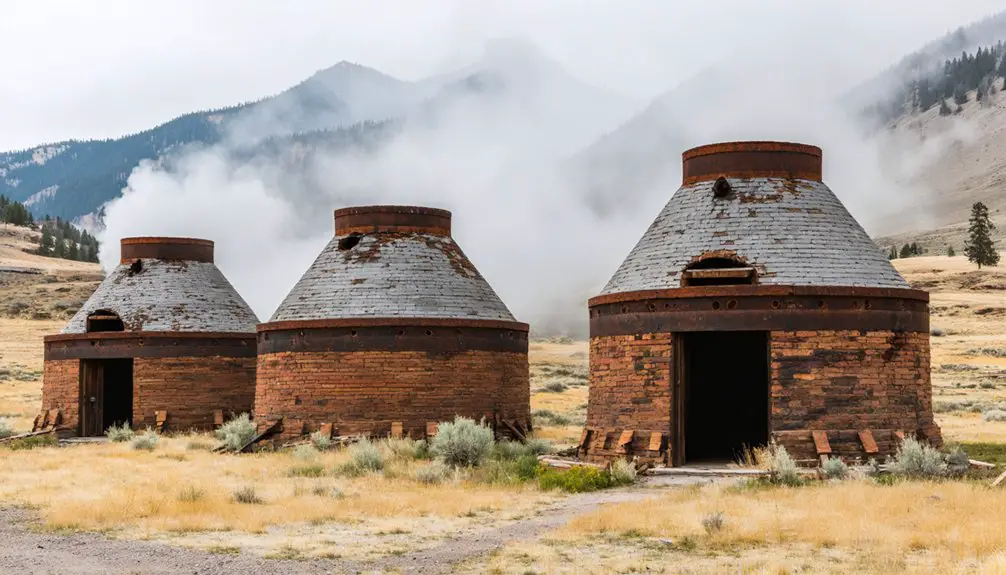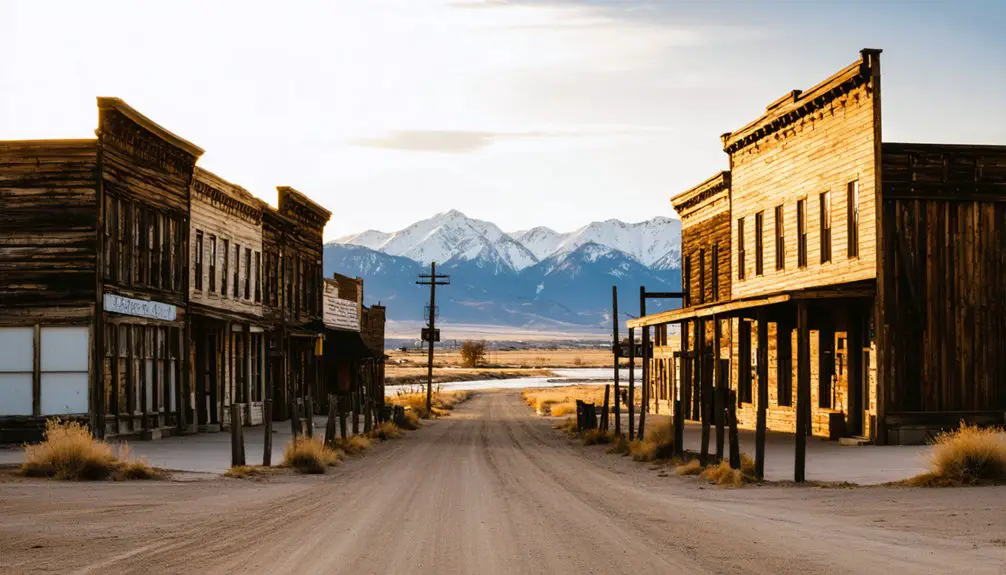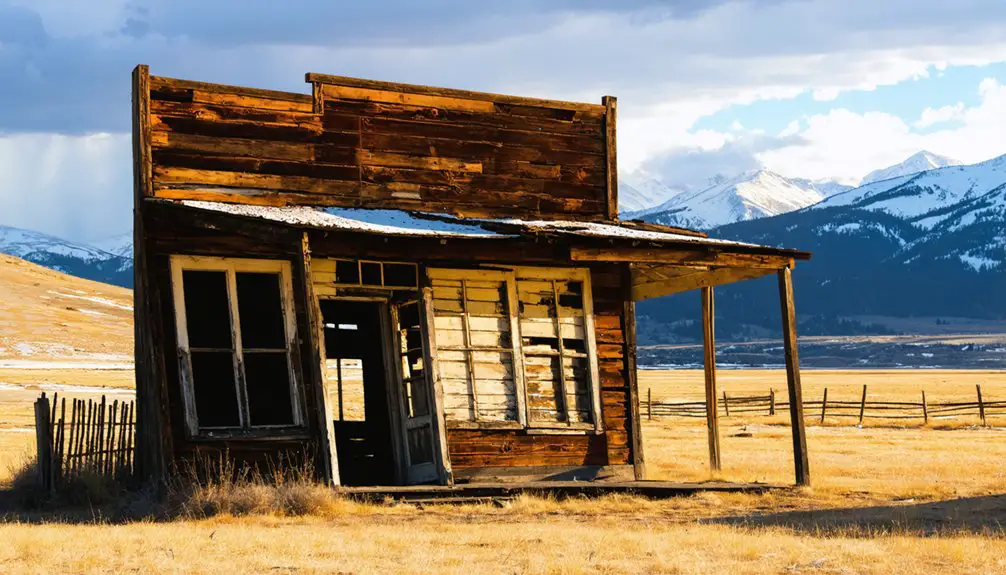You’ll find historic Melrose, Montana along I-15, where it preserves the legacy of a thriving 1870s silver mining empire. The town served as an essential railroad hub connecting the Hecla Mining District’s operations, with a peak population of 2,000 residents. Today, you can explore Victorian commercial blocks, a preserved 1870s railroad hotel, and nearby ghost towns like Glendale. The surrounding Beaverhead-Deerlodge National Forest holds countless stories of Montana’s mining heritage.
Key Takeaways
- Melrose served as a crucial railroad hub during Montana’s silver boom, reaching a peak population of 1,500-2,000 residents.
- Victorian commercial blocks and an 1870s railroad hotel remain as key historical structures in present-day Melrose.
- The town connected multiple mining operations, facilitating ore transport to Butte and Glendale via the Utah Northern Railroad.
- Thirteen saloons, merchants, and essential services supported the mining community during its prosperous period.
- Melrose can be accessed from I-15 Exit 93, with nearby ghost town sites requiring 4×4 vehicles for exploration.
The Rise of the Hecla Mining District
When prospectors discovered silver ore in Montana’s Bryant district in July 1873, they set in motion the development of one of the region’s most prosperous mining areas.
You’ll find the Hecla history began with the Forest Queen claim in 1872, followed by James Bryant’s return in 1873 to expand exploration. The district quickly spawned four thriving camps: Trapper City, Lion City, Glendale, and Hecla. To avoid confusion with other locations named Hecla, the camp was often referred to as Montana’s Hecla.
The area’s mining innovations took off when Henry Knippenberg reorganized the Hecla Company in 1881. Under his leadership, the town of Hecla grew to house up to 1,800 residents and boasted modern amenities like water systems and fire protection. The town established a school for 200 pupils to serve the growing mining community.
A four-mile narrow-gauge tramway connected the mine to its mill, revolutionizing ore processing and transport in the district.
Life in Montana’s Silver Boom Towns
You’ll find that daily life in Montana’s silver mining towns revolved around the rhythms of underground work shifts, with miners descending into shafts for grueling 10-12 hour workdays.
After their shifts, these hardworking men would often gather at the town’s saloons and boarding houses, where they’d find comfort in simple meals, card games, and conversation with fellow miners. The bustling social scene typically included thirteen saloons where miners could unwind.
Despite the harsh conditions and transient nature of boom town life, miners created tight-knit communities, organizing social events and establishing gathering spots that helped them cope with their demanding occupation. Miners had to perform regular claim work requirements to maintain their rights to mine the land, adding another layer of responsibility to their already challenging lives.
Daily Mining Town Routines
Life in Montana’s silver boom towns followed distinct daily rhythms shaped by the demanding mining industry and growing community needs.
You’d find miners working grueling shifts in harsh conditions while their families managed complex household duties. Women tackled daily chores like preparing meals, making candles, and providing medical care for their children. Unlike many mining camps that were dominated by single men, these towns featured family-oriented communities. Health hazards were constant, with miners facing dangerous working conditions that often led to injury or death.
Beyond the mines, you’d encounter a bustling community where merchants, bakers, and blacksmiths served the town’s essential needs. Local assayers evaluated precious metals while supply ships and railroads transported goods to and from these remote settlements.
Family dynamics evolved as schools and churches established roots, bringing stability to these rapidly growing communities. Despite the challenges of poor sanitation and disease outbreaks, residents created structured lives amidst the boom town’s constant activity.
Silver Miners’ Social Life
Despite long hours underground, Montana’s silver miners built vibrant social lives centered around Union Halls, saloons, and dance halls that served as the heartbeat of these bustling communities.
You’d find a rich tapestry of ethnic diversity, with distinct neighborhoods like Finnlander Lane and Cornish Row reflecting the multicultural spirit of these boomtowns. The wealthier residents and mine managers made their homes along Silk Stocking Row. As settlements grew more permanent, miners and entrepreneurs established general stores and barbershops to serve the community’s daily needs.
- Your evenings might include stage productions and concerts at the Union Hall, where miners from all backgrounds gathered for entertainment.
- You’d discover saloons doubling as community centers, offering everything from card games to reading rooms.
- You could join the regular social gatherings at dance halls, where miners shed their work clothes for a night of revelry.
- You’d experience the cultural fusion of different immigrant groups through their customs, cuisines, and celebrations.
Mining Operations and Economic Impact
You’ll find that Melrose’s mining operations centered around a sophisticated network of silver production facilities, anchored by the Hecla Mining Company’s smelter in nearby Glendale.
The town’s 23 beehive charcoal kilns, built between 1881-1884, provided essential fuel for silver smelting operations, marking a significant upgrade from traditional pit methods.
The discovery of phosphate deposits in 1910 diversified the area’s mining portfolio beyond precious metals.
Melrose’s strategic position as a railroad hub strengthened its role in the regional mining economy, connecting multiple productive mines to critical transportation networks while supporting a thriving commercial district.
During peak operations, the area’s population reached 1,500 to 2,000 residents as the mining industry flourished.
Silver Production Dominance
The silver mining operations around Melrose, Montana yielded over $20 million in silver and lead production through the Glendale smelter during the late 19th century.
You’ll find this remarkable output was supported by advanced silver extraction techniques at the time, though mining workforce challenges persisted due to difficult working conditions.
The region’s silver dominance was characterized by:
- Rich silver deposits discovered in 1872 near Lion Mountain, forming the prosperous Hecla mining district
- A massive 40-ton lead smelter built in Glendale by 1875 to process the abundant ore
- Production of 1.2 million bushels of charcoal in 1895 to smelt 40,000 tons of ore
- Shallow but profitable silver veins formed by both hot ascending and cold descending waters
Smelting Infrastructure Development
Supporting the vast silver production in Melrose, an extensive smelting infrastructure took shape during the 1870s and 1880s.
You’ll find evidence of this industrial might in the 40-ton smelter constructed in Glendale in 1875, which processed nearly one million ounces of silver annually at its peak. The operation’s success relied heavily on advanced smelting techniques powered by charcoal production from twenty-three beehive kilns near Melrose.
The Utah Northern Railroad‘s arrival in 1881 revolutionized the logistics, connecting Melrose to broader markets while ensuring steady supplies for the smelting operations.
The infrastructure supported both the Hecla Mining Company’s needs and transformed Melrose into a bustling commercial hub.
Today, you can still see the remnants of this industrial heritage in the standing smelter stack and historic kiln ruins.
Multi-Mine Economic Network
Within Beaverhead County‘s expansive mining district, Melrose emerged as a significant hub in Montana’s multi-mine economic network, where phosphorus-phosphates served as the primary commodity alongside deposits of fluorine, vanadium, and uranium.
You’ll find that mining collaboration between various sites created a robust economic ecosystem, with operations managed by both government entities and private companies like Stauffer Chemical Co.
- The Utah Northern Railroad connected you to key processing centers in Butte and Glendale, enabling efficient ore transport.
- Resource sharing between mines included the essential charcoal kilns that fueled Hecla’s silver smelter.
- You’d see freight stops and railroad hotels supporting the movement of miners and traders.
- Your mining activities drove the growth of support industries, from supply stores to boarding houses, creating a self-sustaining economic network.
The Legacy of Canyon Creek Charcoal Kilns

Standing as silent sentinels of Montana’s industrial past, Canyon Creek’s twenty-three massive brick kilns once played a vital role in the region’s mining operations during the 1880s.
You’ll find these impressive 20-foot-tall conical structures that transformed local lodgepole pine into high-quality charcoal for the Glendale smelter, where silver and lead ore processing generated over $20 million in revenue.
Italian and French Canadian immigrants worked these kilns, carefully monitoring the burning process for six to eight days to produce ideal charcoal.
Their labor came at an environmental cost – the operation consumed nearly 17 square miles of forest over its lifetime.
Today, these preserved kilns serve as monuments to both the ingenuity of immigrant workers and the resource-intensive nature of 19th-century industry.
Exploring Ghost Town Remnants Today
As you venture into Montana’s historic Hecla Mining District near Interstate I-15, you’ll discover the scattered remnants of a once-thriving silver mining empire.
Your ghost town exploration reveals a raw glimpse into the region’s mining heritage, with historic structures and mining relics spread across the rugged landscape.
For the most rewarding experience:
- Start at Exit 93 on I-15, taking Trapper Creek Road to access the district’s key sites
- Bring a 4×4 vehicle or ATV to navigate the challenging terrain beyond Glendale
- Visit Melrose’s Victorian commercial blocks and 1870s railroad hotel along Hecla Street
- Explore the brick dome charcoal kilns and Glendale’s surviving smelter stack
While many structures have succumbed to time, the remaining buildings and foundations tell compelling stories of Montana’s boom-and-bust mining era.
Natural Landmarks and Geographic Features

The rugged Pioneer Mountains cradle Melrose’s historic landscape, where the Big Hole River winds through terrain marked by dramatic elevations ranging from 4,949 feet at Beaverhead Rock to 9,550 feet atop Lion Mountain.
You’ll discover natural formations that have shaped the region’s history, including the iconic Beaverhead Rock – a distinctive landmark that guided Sacajawea in 1805.
The area’s rich river ecosystems support diverse wildlife within the Beaverhead-Deerlodge National Forest.
Canyon Creek and Trapper Creek cut through the mountainous terrain, their waters flowing past remnants of mining operations and ghost towns.
You can access these pristine waterways at several points, including Salmon Fly, Maidenrock, and Brownes Bridge Fishing Access Sites, where world-class trout fishing awaits.
Historical Preservation and Tourist Attractions
Montana’s rich mining heritage lives on through dedicated preservation efforts near Melrose, where organizations like the Montana Ghost Town Preservation Society work tirelessly to protect these historic treasures.
Despite preservation challenges from harsh weather and time’s passage, you’ll find carefully maintained sites that bring the past to life.
Time and weather test these historic treasures, yet each preserved site stands as a living window to Montana’s past.
Here’s what you can explore in the area:
- Bannack State Park, Montana’s best-preserved ghost town, featuring protected structures and interpretive walking tours
- Garnet Ghost Town’s 30 original buildings, maintained through arrested decay techniques
- Lion City/Hecla’s mining remnants, including abandoned cabins and stamp mill ruins
- The historic Big Hole Pump Station, a registered engineering landmark
Tourist engagement continues to grow through guided tours, UTV adventures, and educational programs that support ongoing preservation efforts while offering you an authentic glimpse into Montana’s mining past.
Frequently Asked Questions
Are There Any Reported Ghost Sightings in the Abandoned Mining Towns?
You won’t find documented ghostly encounters or credible paranormal activity in these mining towns. While the ruins might feel eerie, there aren’t any substantiated reports of actual ghost sightings in these locations.
What Happened to the Residents After the Mines Closed?
You’ll find residents scattered as they faced economic impact, with most migrating to larger Montana cities or new mining areas, while others turned to farming in nearby communities like Melrose.
Can Visitors Take Artifacts Found at the Ghost Town Sites?
Like the fleeting past slipping through time’s fingers, you can’t take artifacts home. It’s illegal and harms artifact preservation efforts. Document through photos instead to avoid serious legal implications.
Is Metal Detecting Allowed in the Historic Mining Areas?
You can’t metal detect in historic mining areas due to strict metal detecting regulations protecting their historical significance. You’ll need explicit written permission and permits from authorities managing these protected sites.
Are There Guided Tours Available of the Ghost Towns?
You won’t find dedicated guided tours of ghost towns, though you can access historical sites independently. Some outfitters like Pintler Adventures offer guided explorations of broader areas with historical significance.
References
- https://www.youtube.com/watch?v=Y_j6RF66jqs
- https://en.wikipedia.org/wiki/Hecla
- https://southwestmt.com/ghosts/ghost-towns/glendale-and-canyon-creek-charcoal-kilns/
- https://southwestmt.com/communities/melrose/
- https://silverbowclub.com/canyon-creek-charcoal-kilns/
- https://westernmininghistory.com/towns/montana/hecla/
- https://www.hecla.com/wp-content/uploads/Hecla-company-history-HMC-125Years.pdf
- https://www.legendsofamerica.com/mt-hecla/
- https://westernmininghistory.com/mine-detail/10196635/
- https://en.wikipedia.org/wiki/Montana_silver_mining



